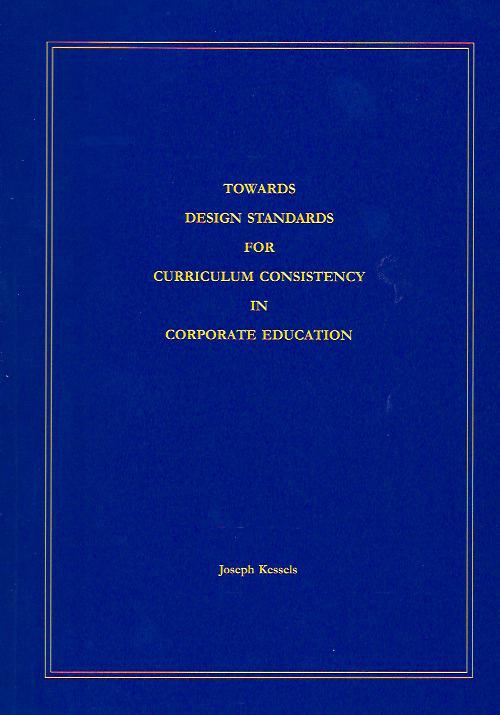Kessels, J.W.M. (1993). Towards design standards for curriculum consistency in corporate education. PhD Thesis. University of Twente.

Kessels, J.W.M. (1993). Towards design standards for curriculum consistency in corporate education. PhD Thesis. University of Twente.
Introduction
(There are still a few copies of this PhD thesis available)
The aim of this study is to develop a set of practical design standards that can be used in the context of corporate education. Economic, social and cultural turbulence in society results in a continuous need to adapt to an ever-changing environment. Learning is considered a major vehicle for organizations to implement the necessary structural, technological and cultural transformations that are needed to grow, or at least to survive.
Design standards for corporate education focus primarily on the acquisition of skills that are sustained by the work environment; skills that should bring about intended changes in employee performance and an impact on the organization. The Body of knowledge on public education provides the broad theoretical foundation for such design standards. Moreover, the complex mechanisms in corporate education, where cognitive operations of individual learning intertwine with social processes of an organizational context, demand an extended theory that seeks to explain the current successes and failures of training systems and predicts the results of new actions. However, such a study should avoid the immodesty of presenting a grand theory that pretends to solve all problems in the field. Nor can it inquire in depth into trainer behaviour and trainee background variables as age, gender, intelligence, culture, and previous education.
Corporate education provides intentionally designed learning situations aiming at the interactive effects of individual and organizational behaviour. Therefore, the curriculum design theory needed should not only incorporate indicators for the development of curriculum materials, but also prescribe approaches that relate to the strategic issues of an organization, to structural feedback mechanisms, as well as to the design of a work environment that inherently holds constructive educational values.
Research Questions
Thus, this study aims to develop a prescriptive theory and valiDatumd design standards for corporate education, and as such addresses the following research questions:
1. Which factors in curriculum design influence quality in corporate education?
2. How do these factors operate?
3. Can design standards control these factors?
External Consistency
External consistency refers to the coherence between the perceptions of the above-mentioned curricula by (top) management, developer, supervisor, trainer and trainee (the actors). External consistency not only depends on activities of the developer but is also favoured by a positive learning climate and an active corporate education policy.
Internal Consistency
As well as having external consistency among the actors' perceptions, a curriculum should be consistent in itself. This concept of internal consistency applies to the logic contingencies between
- the changes that are needed in the work environment,
- the necessary skills of managers and employees to bring about these changes, and
- the learning situations that facilitate the acquisition of these skills.
By the same token, internal consistency also implies that
- learning processes should enable employees
- to acquire skills
- that influence their performance, so that
- the affected work environment has
- an impact on the organization
The concept of curriculum consistency - the contingencies between its elements and the congruences between its appearances - is an elaboration of Stake's model for curriculum evaluation. Throughout this study, curriculum consistency, both internal and external, is used as a descriptive framework for quality in corporate education.
Design Approaches
The primary purpose of developing and applying design standards is to improve the internal consistency of a curriculum and to gear towards a strong external consistency between the curriculum perceptions of the actors in corporate education, thus resulting in an attained curriculum that is consistent with the ideal curriculum.
When design instructions are to influence curriculum consistency, the question arises as to which mechanisms bring about internal and external consistency. The theory developed here advocates a systematic and a relational approach that seems to trigger a powerful combination of systems thinking and social integration (Chapter 3). The integration of a systematic and relational approach in design instructions is held responsible for curriculum consistency and subsequently for corporate education of a high standard.
Systematic Approach
The systematic approach implies the logical design sequence of orientation, design, development, implementation and evaluation. Specific instruments used are needs assessment techniques, instructional objectives, learning strategies, training materials, guidelines for trainers and evaluation instruments. The systematic approach, when skilfully applied, leads to a well structured and logically ordered programme design with a strong internal consistency. This design on paper is referred to as the formal curriculum.
Relational Approach
The relational approach provides activities that challenge actors to become involved in the design and implementation process and that reveal their perceptions of the ideal curriculum. When the mutual perceptions are explicit, they can be modified and slowly become compatible. The relational approach facilitates actors' involvement in the design and implementation process and has an impact on management commitment to corporate education. When skilfully applied, the relational approach leads to a strong external consistency among actors' curriculum perceptions.
Two empirical studies
The basis for design instructions that enhance curriculum consistency is found in existing theory and analysis of empirical findings. The empirical research that was carried out in this study encompasses four main stages: analysis of 17 contrasting cases, development of design instructions, the training of 30 developers, and finally the development, implementation and evaluation of 28 new curriculum projects.
